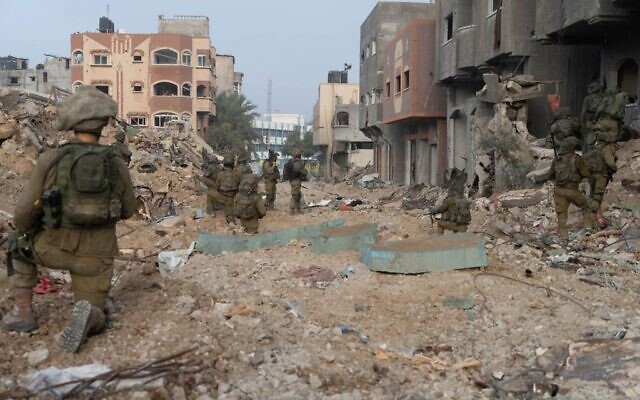Israel won’t seek ‘pause’ without hostage guarantee
Temporary humanitarian corridors might be feasible and negotiated in return for the freedom of hostages

George Orwell once observed that in war pacifists harm the military effort of their democracy and give military advantage to their opponents.
Anthony Albanese is calling on Israel to pause its war efforts for humanitarian reasons – in effect a ceasefire. US Secretary of State Anthony Blinken is also urging Israel to pull its punches with “humanitarian pauses”, while the UN Secretary-General has called for an immediate ceasefire.
Prime Minister Benjamin Netanyahu has rebuffed these requests. But talks are reported to be underway for a significant pause on condition of the release of hostages. Hamas has threatened to livestream executions of hostages, reminding us of Islamic State’s tactics. A cessation would facilitate the redeployment of Hamas combatants and movement of Hamas hostages and supplies, using its 500 kilometre maze of tunnels and costing the lives of Israel’s soldiers. There’d need to be some beneficial exchange for Israel in the form of saved hostages.
Israel won’t be persuaded by international opinion. It will make its own decisions. Israel’s military doctrine has been to defend itself without external support since its independence in 1948. However, as this war will extend over months, the tide of supportive opinion among its allies will turn, potentially threatening supply chain logistics.
Regular pauses in Israeli military operations for limited humanitarian corridors might be feasible to allow aid to come in from Egypt by land and Cyprus by sea. They’d need to be subject to agreed supervision to prevent their use to equip Hamas.
Arrangements have already been put in place for aid trucks currently arriving daily in Gaza from Egypt, which Israel enables where it’s conditioned by safeguards. This humanitarian flow is inward only.
Egypt isn’t allowing Palestinians to leave Gaza into Egypt. Hamas inserted its wounded fighters among those to be evacuated, which neither Egypt nor Israel want and evacuations were suspended. Humanitarian corridors are co-operative, not unilateral, endeavours.
Critics of Israel argue military operations in Gaza are disproportionate, lacking regard for civilian lives. But the laws of war don’t require equivalence. Equivalent atrocities to those of Hamas are prohibited.
The concept of proportionality in international law requires that attacks use the minimum force necessary to destroy a legitimate military target, and without causing civilian loss. The requirement doesn’t apply with the benefit of hindsight. It projects forward, reliant on military intelligence available at the time of the attack.
Have civilian casualties caused by Israel been excessive so far? Hamas figures claim over 9000 casualties, but its Ministry of Health doesn’t makes distinctions between Gazan civilians and Hamas combatants. Hamas has 20,000-40,000 fighters. In armed conflicts globally, civilian deaths are now usually more than double those of combatants. In past conflicts between Hamas and Israel, the Gazan civilian death rate was much lower, only 15-25 per cent of all casualties.
But those conflicts were limited, pinpoint military operations. In the current full-scale war, the rate of civilian carnage may approach 2:1. Furthermore, 20 per cent of Gazan civilians are killed by Hamas itself, through mishaps and repression.
Israel has sought to reduce the civilian death rate by providing evacuation warnings, weeks prior to its ground operations especially, and creating safe corridors for evacuation.
In contrast, to deter evacuation, Hamas uses civilians as shields and has shot or blown-up those seeking to flee Gaza City.
Its subterranean command, intelligence, supplies storage, weapons, and ammunition dumps are deliberately located under protected civilian sites such as hospitals, schools, and UN compounds.
Hamas’s leaders have clarified that the tunnels are there to protect its fighters, not civilians.
US generals have advised that Israel might consider using smaller diameter bombs. Nevertheless, these still need to be deep ground penetrating.
Let’s not be hypocritical but admit that Hamas equals Islamic State in terms of savagery at its height. In Mosul, 6000-12,000 Islamic State forces were embedded among the civilian population when the recovery operation began in 2016. The operation took nine months. Around 9000 to 10,000 civilians were killed in battle. Mosul was then larger than Gaza City but less densely populated and Hamas is more deeply embedded than Islamic State was.
There was extensive use of air strikes and artillery in Mosul by the coalition forces. These were focused on military targets. Unavoidable civilian deaths were caused by them. The international community didn’t just support the complete elimination of the Islamic State, it actively participated in the military operations.
Israel needs the time and space to defeat a terrorist organisation active in genocide against Jews and Israelis. Stopping before Hamas is destroyed ensures that worse atrocities will follow, as promised by its leaders. An Israeli ceasefire or general pause for humanitarian purposes would provide Hamas with benefits from its use of civilian shields. But temporary humanitarian corridors might be feasible and negotiated in return for the freedom of hostages. These are the dilemmas of war.
Greg Rose is professor of law at the University of Wollongong. Anthony Bergin is senior fellow at Strategic Analysis Australia. A version of this article appeared in The Australian.

comments